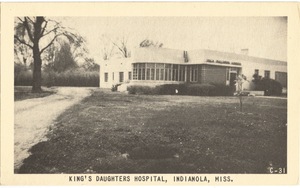KING’S DAUGHTERS HOSPITAL AT INDIANOLA, 1939-1952— This image, which dates to 1939, is a postcard of 25-bed King’s Daughters Hospital at Indianola, Mississippi. It was built in 1938 for $35,000 by contractor S. P. Aswell of Belzoni and opened as an institution on October 22, 1939.1,2 Despite its relative importance among the Delta’s population centers, Indianola was slow to develop a full-service community hospital. Indianola had a strong King’s Daughters Chapter engaged in many public health efforts, and as in many other communities across the state, the King’s Daughters Chapter was focused on the creation of a local hospital. Mrs. W. H. Carothers, Membership Chairman of the Indianola Chapter of King’s Daughters and Sons, asked in a public letter in May of 1927: “Is it not time for Sunflower County to begin work for a King’s Daughters Hospital of its own— where our people within its borders, can get treatment at a lower cost than in other places?”3,4 During the great flood of 1927, the chapter had established hospitals for “both white and colored,” and maintained them until taken over by the Red Cross. These relief hospitals cared for large numbers of patients utilizing the services of local physicians, trained nurses, and ladies from Indianola. These relief hospitals had proven to the chapter that the creation of a hospital was an achievable and necessary goal.5
A serious movement to establish a hospital in Indianola, specifically to erect a King’s Daughters Hospital, began in 1935-36.6 As the planning for the hospital evolved, it was conceived in the traditional King’s Daughters perspective as a facility to treat everyone in the community, Black and White, rich and poor. The local newspaper reported, “There will be a negro ward, a negro operating room, so that our colored people may have treatment here instead of having to be sent at great expense to Vicksburg and elsewhere. There will be a white operating room, too. Everything will be as good as money can buy and we are informed that an excellent general surgeon will locate in Indianola if the hospital is established.”7 The King’s Daughters movement was successful, with the building of the hospital by 1938 and its opening in 1939.1 The hospital operated at “full-capacity” most of its existence, it was reported, and “the need soon developed for more room.”2 Original plans in 1947 were for an annex to expand the hospital. However, with the passage of the Hill-Burton Act, local leaders realized with federal help a much larger new hospital could be built. By 1949, plans for a new 50-bed hospital in Indianola were drawn up, and the King’s Daughters Hospital was transferred gradually from King’s Daughters ownership to county ownership and operation, with the creation of the South Sunflower County Hospital District.8,9
Dr. M. W. Swartz, a well-known local banker and financier (a PhD doctor, not an MD), was a major figure in the opening and operation of both facilities, long serving as chairman of the King’s Daughters board of directors.10 He was a significant community leader in the transition from one hospital to the next. King’s Daughters served as Indianola’s primary hospital until the construction and opening of South Sunflower County Hospital, which still claims descent from the original Kings Daughters Hospital. South Sunflower’s construction was largely completed by 1951,11 but its opening was delayed until the next year. The $496,000 South Sunflower County Hospital, designed by Jackson architects Jones and Haas, officially opened in May 1952, with “53 beds, a medical staff of eleven, sixteen nurses, bookkeeper, and other personnel.” The old King’s Daughters structure, which was located directly across the street from the new hospital’s four-acre site on U. S. Highway 82 (facing Baker Street), was converted into a nurse’s home after its services moved to the new hospital structure.12
If you have an old or even somewhat recent photograph which would be of interest to Mississippi physicians, please send it to me at drluciuslampton@gmail.com or by snail mail to the Journal. — Lucius M. “Luke” Lampton, MD; JMSMA Editor


